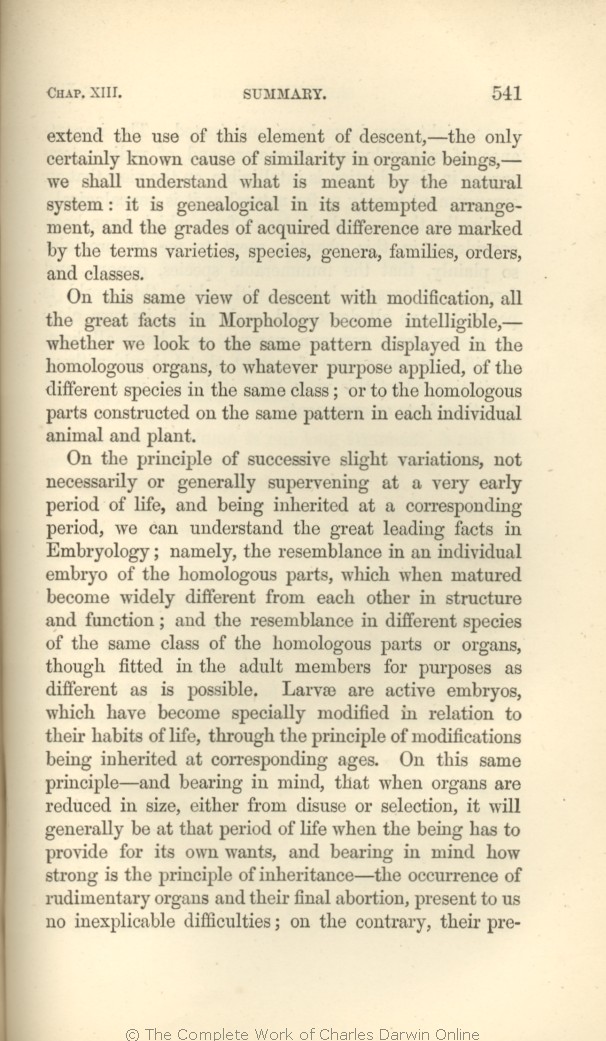extend the use of this element of descent,— the
only | only 1859 1860 1861 1866 | | one 1869 1872 |
| natural 1859 1860 1861 1866 | | Natural 1869 1872 |
| system: 1859 1860 1861 1866 | | System: 1869 1872 |
| and 1866 | | with 1859 1860 1861 1869 1872 |
| are marked 1866 | | marked 1859 1860 1861 1869 1872 |
| terms 1859 1860 1861 1866 | | terms, 1869 1872 |
|
|
On this same view of descent with modification,
all | all 1859 1860 1861 1866 1869 | | most of 1872 |
| in 1859 1860 1861 1866 | | by 1869 1872 |
| homologous organs, to whatever purpose applied, 1859 1860 1861 1866 |
| different species 1869 1872 |
| different species in the same class; 1866 |
| different species of a class; 1859 1860 1861 |
| same class in their homologous organs, to whatever purpose applied; 1869 1872 |
| homologous parts constructed on the same pattern 1859 1860 1861 1866 |
| homologous parts 1869 |
| serial and lateral homologies 1872 |
|
|
On the principle of successive slight variations, not necessarily or generally supervening at a very early period of life, and being inherited at a corresponding period, we can understand the
great | great 1859 1860 1861 1866 1869 | great 1872 |
| resemblance in an 1859 1860 1861 1866 |
| close resemblance in the 1869 1872 |
| homologous parts, which 1859 1860 1861 1866 |
| parts which are homologous, and which 1869 1872 |
| ..... 1861 1866 1869 1872 | | will 1859 1860 |
| from each other 1859 1860 1861 1866 |
| OMIT 1869 1872 |
| in different species of the same class of the 1866 |
| in different species of a class of the 1859 1860 1861 |
| in allied though very distinct species of their 1869 |
| of the 1872 |
| organs, 1859 1860 1861 1866 1869 | | organs 1872 |
| though 1859 1860 1861 1866 1869 |
| in allied though distinct species, though 1872 |
| members 1859 1860 1861 1866 | | state 1869 1872 |
| purposes 1859 1860 1861 1866 1869 | | habits 1872 |
| is possible. 1866 1869 1872 | | possible. 1859 1860 1861 |
| become 1859 1860 1861 1866 | | been 1869 1872 |
| relation 1859 1860 1861 1866 |
| a greater or less degree in relation 1869 1872 |
| through the principle of modifications being 1859 1860 1861 1866 |
| with their modifications 1869 1872 |
| corresponding 1859 1860 1861 1866 |
| a corresponding 1869 |
| a corresponding early 1872 |
| ages. 1859 1860 1861 1866 | | age. 1869 1872 |
| this 1859 1860 1861 1866 | | these 1869 1872 |
| principle— 1859 1860 1861 1866 | | principles,— 1869 1872 |
| selection, 1859 1860 1861 1866 |
| through natural selection, 1869 1872 |
| principle 1859 1860 1861 1866 | | force 1869 1872 |
| and their final abortion, present to us no inexplicable difficulties; on the contrary, their pre- sence might 1866 |
| and their final abortion, present to us no inexplicable difficulties; on the contrary, their presence might 1859 1860 1861 |
| might even 1869 1872 |
|









